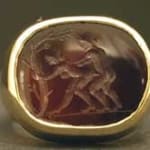Gold Ring Featuring a Classical Revival Carnelian Seal Depicting Two Lovers, 18th Century CE - 19th Century CE
Carnelian, Gold
FJ.6666
This Antique Seal Has Been Set in a Modern 18 Karat Gold Rin The art of glyptics, or carving images on colored precious stones, is probably one of the oldest...
This Antique Seal Has Been Set in a Modern 18 Karat Gold Rin
The art of glyptics, or carving images on colored precious stones, is probably one of the oldest known to humanity. Intaglios, gems with an incised design, were made as early as the fourth and third millennia B.C. in Mesopotamia and the Aegean Islands. They exhibit a virtuosity of execution that suggests an old and stable tradition rooted in the earliest centuries. The tools required for carving gems were simple: a wheel with a belt-drive and a set of drills. Abrasives were necessary since the minerals used were too hard for a metal edge. A special difficulty of engraving intaglios, aside from their miniature size, was that the master had to work with a mirror-image in mind.
The Classical Revival was a phenomenon that swept across Europe during the 18th and 19th Centuries. A new appreciation for antiquity and ancient art forms was fostered by discoveries in the nascent scientific field of archaeology. Perhaps the Classical Revival also reveals a latent longing towards the Arcadian lifestyles of yesterday abandoned as Europe became rapidly industrialized and increasingly urbanized. On this stunning intaglio, a pair of joined lovers is represented in a natural outdoor setting as suggested by the tree. This seal clearly reveals an innate longing for simpler times and the pastoral Utopia left behind as mankind progresses forward into the future. Wearing this ring, one shows they have the time to enjoy the finer things in life, free from the distractions of the daily hustle and bustle.
The art of glyptics, or carving images on colored precious stones, is probably one of the oldest known to humanity. Intaglios, gems with an incised design, were made as early as the fourth and third millennia B.C. in Mesopotamia and the Aegean Islands. They exhibit a virtuosity of execution that suggests an old and stable tradition rooted in the earliest centuries. The tools required for carving gems were simple: a wheel with a belt-drive and a set of drills. Abrasives were necessary since the minerals used were too hard for a metal edge. A special difficulty of engraving intaglios, aside from their miniature size, was that the master had to work with a mirror-image in mind.
The Classical Revival was a phenomenon that swept across Europe during the 18th and 19th Centuries. A new appreciation for antiquity and ancient art forms was fostered by discoveries in the nascent scientific field of archaeology. Perhaps the Classical Revival also reveals a latent longing towards the Arcadian lifestyles of yesterday abandoned as Europe became rapidly industrialized and increasingly urbanized. On this stunning intaglio, a pair of joined lovers is represented in a natural outdoor setting as suggested by the tree. This seal clearly reveals an innate longing for simpler times and the pastoral Utopia left behind as mankind progresses forward into the future. Wearing this ring, one shows they have the time to enjoy the finer things in life, free from the distractions of the daily hustle and bustle.



